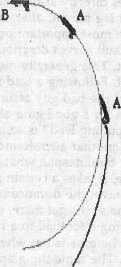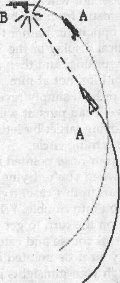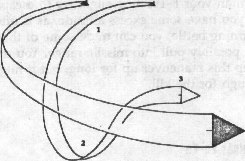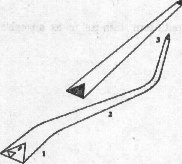The Official F-19 Stealth Fighter Handbook
by Richard Sheffield
Pursuit Curves
There are three kinds of pursuit curves: lag, pure, and lead. Most people instinctively use pure pursuit—they point the nose of their planes directly at the bad guys. This approach is okay, but lead and lag pursuit offer distinct advantages in F-19 Stealth Fighter. The most important one to know about in F-19 is lead pursuit. Pursuit curves describe the course you take as you follow a target. This generally means where you point the nose of the aircraft. Following a lead pursuit curve, keeping your nose ahead of the bad guy assures that you can “pull lead” on the target for a good guns shot.
Here's why “pulling lead” is so important. If you're in a turning fight with another aircraft and you have your nose pointed directly at him, despite what you may think, he's perfectly safe. You see, it takes a certain amount of time for the shells you fire to travel the distance between you and the target. By the time the shells get there, the target will be gone. It's just like throwing a football to a running receiver. You don't throw it to where he is but where he'll be by the time the ball gets there. The same thing applies to gunnery. You must shoot where the target will be, not where it is.

This illustration shows why Pure Pursuit will not work in a gun battle. At position A the attacker has his nose pointed directly at the bogey. But if he fires, the bogey will move to position B before the shells arrive, causing a miss.

By taking a Lead Pursuit curve and pointing his nose AHEAD or the bogey at position A, the attacker is able to “pull lead” and aim his cannon shells in front of the target so that the shells and the target both arrive at position B simultaneously.
When you're following a target in a lead-pursuit curve, you have lead on that target. In other words, your nose is pointing in front of the target, not at it. This allows you to shoot where the target will be, not where it is. If you get into an engagement using lead pursuit from the beginning, you won't have to outturn your opponent. Rather than flying straight at him, use the Tactical display or the TrackCam to see which way he is heading or turning, and then approach with your nose pointed in front of him, not at him. Be careful not to lead the target too much or he'll simply reverse his course and put you on the defensive. Lead pursuit will also allow you to close range on a faster moving target by letting you “take a shortcut” and cut across the turning circle.
Lag-pursuit, or keeping your nose pointed behind the target, can be effectively used when you're trying to track a maneuvering target from the rear. In this case, trying to pull lead on the target will only get you into trouble. What generally happens is as you pull hard on the turn to get your nose ahead of the target, he reverses course and catches you going the wrong way. By keeping your nose pointed behind the target, he'll have to pass through your gunsights if he reverses course, giving you the chance for a quick guns shot. By maintaining a lagpursuit position you'll also be able to maintain a speed advantage over the enemy. If he does not reverse, you may be able to force him into an ever-tightening turn. Sooner or later he will run out of airspeed or altitude and be forced to make a straight line run for it. Then you can use your speed advantage to close for a gun shot or to line him up for a missile.
Lateral Separation
Use lateral separation combined with lead pursuit to attack those unsuspecting targets. Putting a little space between your flightpath and the bogey's will make your turn and attack much easier. That way you won't have to turn and race after him; you'll be able to keep your nose in front of the target the whole time. You can either maintain the lead pursuit until you close the range for a gun shot or slide in behind him and put a Sidewinder up his tailpipe.

The Low Speed Yo-Yo
Since the F-19 spends so much of its time at very low speed and low altitude, many of the classic fighter maneuvers don't translate well. They assume a different kind of fight. One that does work very well, however, is the Low Speed Yo-Yo. There are a number of Yo-Yo maneuvers named after a Chinese fighter pilot who used them in the Korean war. They generally involve maneuvering up or down to decrease or increase airspeed.
The situation for a Low Speed Yo-Yo is when you're in a hard turning fight and cannot out-turn your opponent to pull lead for a gun shot. Since you need to keep the nose up in most hard turns with the F-19, you tend to gain altitude in the process. This Yo-Yo maneuver lets you trade some of that altitude for speed and cut across the turning circle to gain an advantage over the enemy.
To describe the maneuver, let's assume you're in the following situation. You're in a hard turning fight, banking sharply, chasing the tail of an opponent turning in the same direction. To perform the Yo-Yo maneuver you should:
Continue to roll over so you're slightly inverted and pull your nose down so you start an inverted dive. (Note that you're not totally inverted, just d little past a 90-degree bank.) As you roll over, you should momentarily get a stall warning indication. Once you get inverted, it should stop—don't worry about it.
Pull back hard on the stick as you dive to make your turn tighter. The speed you pick up in the dive should keep you from stalling.
You should only stay in this diving turn for a second or two before you roll back over in the opposite direction and pull out of the dive. If you've performed the maneuver well, you should have made up a lot of ground on the bogey.

Roll down inside the other aircraft's turn, then pull up for a possible shot
The Straight Yo-Yo
A similar maneuver can be used to close the range on planes flying away from you. Since most, if not all, enemy aircraft can fly faster than your F-19, they might try to escape by running away. If you have some excess altitude, as is often the case after a turning battle, you can trade some of that altitude for speed and possibly pull into missile range. You might not be able to keep this maneuver up for long, but it might get you close enough for the kill.

Trade altitude for airspeed by making a shallow dive. If you get close enough, pull up for a gun shot or to get the bogey into the missile envelope.
The Forced Overshoot
Enemy pilots seem to have an uncanny ability to know what you're doing almost immediately. This technique uses that against them. If you have a bogey that you just can't shake, you might want to try this somewhat risky maneuver. Let the bogey come around on your tail, but be ready to jink a missile or two. Slow up so you draw him in real close; then go to max power. He'll react almost instantly with max power, too. When he starts to overtake you, cut the engines and put out the brake to force him to overshoot. Almost always, he'll pass above you and turn quickly, usually to the left. Be ready to pull the nose up and shoot as soon as he appears.
Multiple Bogeys
The presence of more than one enemy aircraft presents a whole new set of problems. Now you can't concentrate on one bogey too long or the other will sneak around behind you and let you have it. The enemy has a good deal of intelligence in this game. They frequently place fighter patrols in gaps in radar coverage. Sometimes you have no alternative but to take on two or more fighters. If there's no way to avoid the fight, it's much better to be on the offensive.
Take the fight to the enemy at the first possible moment. Long-range missile shots may be successful and eliminate the need for further battle, or at least even the odds some. If you have several bogeys approaching from different angles, try to take out the most dangerous one first. Or if only one has radar lock on you, go after him first and then hide from the rest until you can plan your attack. Remember, in most cases, especially at night, you can simply disappear.
Also remember, just because two aircraft are heading right for you doesn't mean they have a good fix on your position or even know you're there. Aircraft will always head to the site of the most recent action. So even though it might appear as if they're headed for you, they could be just responding to your latest attack.
Table of Contents
Previous Section: Gun Attacks
Next Section: Fake Attacks
